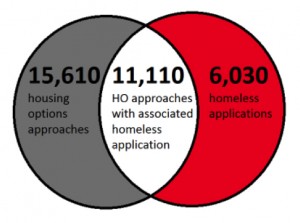This week, the Scottish Government released their quarterly homeless statistics for September to December 2014. The headline statistics were that over this period homeless applications have gone down, homeless assessments have gone down, and there were only 5 households with children in B&B temporary accommodation on 31st December 2014.
Taken at face value this looks like great news. Yet, although the official numbers of homeless applicants is falling, we don’t believe this is because there has been a change in the underlying drivers of homelessness. And it is definitely not because we no longer have a problem with homelessness in this country – the experiences of our clients tells us that at the very least. Looking in more detail, the statistics put into focus specific groups who are at the sharp end of Scotland’s housing system, and for whom the current system still is not working.
The statistics released earlier this week showed that on the 31st of December 2014 (a night when many of us were out celebrating the start of a new year) 4,333 children were living in temporary accommodation. This was an increase of 199 on the previous year. In the context of reducing numbers of homeless applications, and our analysis released in January on how long households are spending in temporary accommodation, we find this particularly concerning.
The average time spent in temporary accommodation was 18 weeks, over 1 in 4 spent over 6 months in a home they couldn’t call their own, and 1 in 10 spent over a year in so-called ‘temporary’ accommodation. Our analysis also showed that households with children spent longer in temporary accommodation than those without.
In addition to this, in 2013-14, for every 1000 people in Scotland, 6.64 were assessed as homeless. For young people, the situation is even worse – under 25s were twice as likely to be homeless, at 13.7 in every 1000.
The number of homeless applications are also not the only measure of housing need. Part of the reason behind the reduction in applications is because of the push towards prevention by local authorities – largely through the ‘housing options’ approach. The first Scottish Government statistics analysing this (known as ‘prevent1’) were released in January and give a fuller picture of housing need in Scotland today: between April 1st and September 30th there were 32,750 approaches/ applications to councils for direct assistance in securing accommodation, and roughly half of these made a homeless application.
We need to understand more about how housing options is operating, particularly after the Scottish Housing Regulator’s report last year which highlighted the ‘not always appropriate’ diversion of people from a homelessness assessment to Housing Options, where some people with clear evidence of homelessness did not go on to have a homeless assessments. The first set of statistics show huge variations in local authorities within their housing options approaches – it is not yet clear whether this is due to practices on the ground or the way the reporting system is working. The experiences of our clients, and the statistics, raise questions for us about who is, and who is not, getting what they need out of the system. What we need to do next is look more closely at what is happening with these groups.


